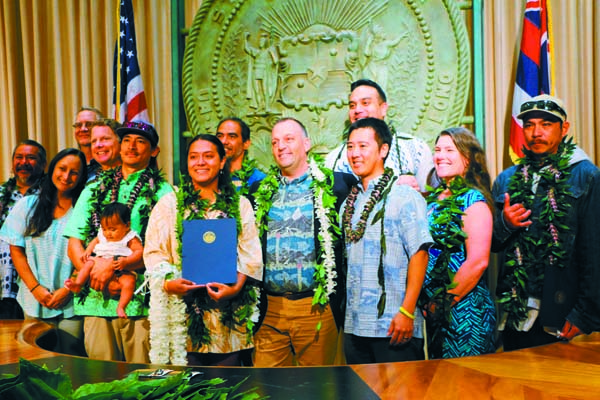March 16, 2024

Governor Josh Green, M.D., signed Community-Based Subsistence Fishing Area (CBSFA) rules into law for the moku of Kīpahulu in the Hāna District of Maui, Friday.
KĪPAHULU, MAUI–Governor Josh Green, M.D., signed Community-Based Subsistence Fishing Area (CBSFA) rules into law for the moku of Kīpahulu in the Hāna District of Maui, Friday. Kīpahulu joins Hā’ena on Kaua’i and Miloli’i on Hawai’i Island, as the third designated CBSFA in the state. Prior to the signing, the Kīpahulu CBSFA rules received unanimous approval by the state Board of Land and Natural Resources.The Kīpahulu community worked with the DLNR Division of Aquatic Resources (DAR), The Nature Conservancy, and other supporters for more than a decade to bring the concept of community-based subsistence fishing to reality.
The Linds, a well-known family of fishers and generational stewards of Kīpahulu, are the driving force behind the Kīpahulu ‘Ohana, Inc. (KOI), a grassroots non-profit organization founded in 1995 by a small group of Native Hawaiian Kīpahulu residents whose mission is “to revive, restore, and share the practices of traditional Native Hawaiian culture with others in Kīpahulu. In addition to what the CBSFA provides, KOI has perpetuated sustainable gathering practices in their stewardship kuleana (responsibility), both on land and in the ocean, for generations.
During a recent interview standing on a rocky shoreline, Pekelo Lind said, “It just comes natural to us. We’ve been taught as young kids to be like, hey protect, don’t take too much. Always was reminded to pick up the trash and leave the place better than you found it. It’s just rooted in the core of us. I feel like we have the experience with dealing with agencies.” That capability, he says, gave the ‘ohana the voice to speak to regulators like DLNR/DAR. “We had the tools to approach agencies to make the CBSFA happen.”
Kamalei Pico, executive director of KOI commented, “We honor our kūpuna who have paved the way for us. Today’s win also honors our community, our people’s connection to place, and reaffirms our collective commitment to aloha ‘āina and to protect our resources in perpetuity. Mahalo nui to BLNR Chair Dawn Chang, and the DAR team of Brian Neilson, Luna Kekoa, Keali’i Sagum, Adam Wong, and David Sakoda, and Governor Green’s administration for their support in seeing this through.”
Pico explained that CBSFAs are just one tool they have long believed could further the vision for ‘āina momona and strengthen communities that depend on the resources of their areas the most. Pico added, “The foundation of Kīpahulu’s CBSFA was developed upon place-based generational knowledge attained through observations of kūpuna and lawai’a, traditional kumukānāwai (codes of conduct) and Native Hawaiian cultural values that govern pono fishing practices. Other communities, especially in the East Maui region, are looking to Kīpahulu’s CBSFA as a model for setting their unique kahua (foundations) and developing strategic fisheries management plans for their own moku.”
In practice, each CBSFA has specific rules that regulate important marine species of that area, harvest amounts, and traditional gathering seasons and methods. Pekelo Lind explained, “We can’t guarantee that everyone will follow the rules. But the CBSFA gives us another upper hand on better regulation. I’m glad that this is how it’s going to help us and give us the tools to hope. We’re still going to have people come in and fish, do their thing. But this gives something in our pockets to help us out, another tool, in other words.”
“The Nature Conservancy is really excited to see KOI achieve this well-deserved milestone, and we look forward to supporting them and DAR as they move forward in implementing their co-management partnership. We’re grateful for all the East Maui and Maui fishers who worked together to make this CBSFA so strong,” said Scott Crawford, Maui Marine Director of The Nature Conservancy.
To witness the broad community support and partnerships developed through Kīpahulu’s journey to establish its CBSFA is so uplifting, and we are hopeful that this will inspire even more communities to take similar actions to protect our shared biocultural resources,” commented Kevin Chang, executive director of Kua’āina Ulu ‘Auamo (KUA), an organization that supported and assisted with the development of the sustainable fishing area.
DAR Education Specialist Adam Wong worked closely with the community and stakeholders to bring the CBSFA to fruition. “Ultimately, it’s the Kīpahulu community that most heavily relies on these resources to sustain their day-to-day life and that’s what we want to help them protect. It’s a state resource as well, for other fishers around the island that love to come out here and fish, like me. We just needed to be sure that everybody was at the table, gather everybody’s mana’o, or input, and find a path moving forward,” Wong concluded.